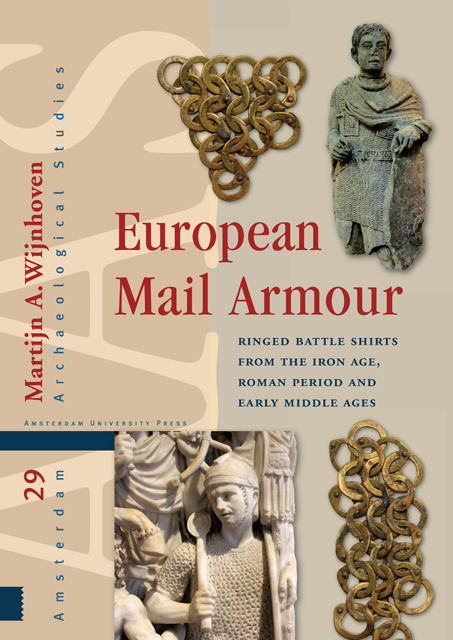Book contents
- Frontmatter
- Contents
- Acknowledgements
- Dedication
- 1 Introduction
- 2 The origins of mail armour
- 3 Distribution and archaeological context
- 4 The iconography of early mail armour
- 5 The naming of mail armour
- 6 Decoration in mail garments
- 7 Padded garments
- 8 The craft of making mail rings
- 9 Weaving patterns
- 10 The construction of mail garments
- 11 Ring characteristics
- 12 Final considerations
- Bibliography
- Database
- Appendix 1 Catalogue of mail armour
- Appendix 2 Catalogue of hybrid armour
- Appendix 3 Catalogue of isolated finds of fasteners and fixtures
- Appendix 4 Finds excluded from the database
12 - Final considerations
Published online by Cambridge University Press: 24 November 2022
- Frontmatter
- Contents
- Acknowledgements
- Dedication
- 1 Introduction
- 2 The origins of mail armour
- 3 Distribution and archaeological context
- 4 The iconography of early mail armour
- 5 The naming of mail armour
- 6 Decoration in mail garments
- 7 Padded garments
- 8 The craft of making mail rings
- 9 Weaving patterns
- 10 The construction of mail garments
- 11 Ring characteristics
- 12 Final considerations
- Bibliography
- Database
- Appendix 1 Catalogue of mail armour
- Appendix 2 Catalogue of hybrid armour
- Appendix 3 Catalogue of isolated finds of fasteners and fixtures
- Appendix 4 Finds excluded from the database
Summary
The past is over, completed, and so much of it is lost in the distance. There are still traces with us, the problem is how to use these to enable us to see the past, to visit the distant past. The traces of the past which we find in the present ‘belong’ to time other than the present. The problem is how to relate to this otherness.’
Michael Shanks & Christopher Tilley
INSIGHTS
This study has aimed to lay down a solid foundation for mail armour research which can be built upon and expanded in the future. The systematic analysis of the evidence for mail through a multi-dimensional approach has proven very productive. It has contributed to our understanding of this type of armour in much more depth and rendered the following insights concerning the four main topics of this study:
ORIGIN AND DISPERSION
There have been several suggestions concerning the predecessors of mail armour. These forerunners all have in common that they are made of (interwoven) metal rings. However, examination of these ringed artefacts demonstrates that they differ in many key aspects from mail armour. Therefore, the supposed predecessors have been called into question.
The invention of mail armour has been attributed to various archaeological cultures during the last two centuries of research. Analysis of the archaeological-, iconographical-, and written evidence makes it possible to assign its origin to the Celts (La Tène culture) around the turn of the 4th to 3rd century BC. Within La Tène society mail pertains to the elite and it is their mobility and far-reaching networks that are responsible for the rapid geographical dispersion of this new technology. Within less than a century after its invention it can be found in many parts of Europe and even beyond. This rapid dispersion makes it impossible to pinpoint the origin of mail to a single region. The earliest finds are all found more or less along the Rhine-Danube corridor, a well-known ‘highway’ of contact between Western and Eastern Europe from prehistory onwards.
- Type
- Chapter
- Information
- European Mail ArmourRinged Battle Shirts from the Iron Age, Roman Period and Early Middle Ages, pp. 313 - 320Publisher: Amsterdam University PressPrint publication year: 2021



